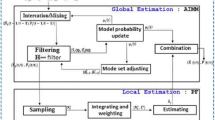Abstract
Multiple object tracking (MOT) poses many difficulties to conventional well-studied single object tracking (SOT) algorithms, such as severe expansion of configuration space, high complexity of motion conditions, and visual ambiguities among nearby targets, among which the visual ambiguity problem is the central challenge. In this paper, we address this problem by embedding adaptive mixture observation models (AMOM) into a mixture tracker which is implemented in Particle Filter framework. In AMOM, the extracted multiple features for appearance description are combined according to their discriminative power between ambiguity prone objects, where the discriminability of features are evaluated by online entropy-based feature selection techniques. The induction of AMOM can help to surmount the incapability of conventional mixture tracker in handling object occlusions, and meanwhile retain its merits of flexibility and high efficiency. The final experiments show significant improvement in MOT scenarios compared with other methods.
Similar content being viewed by others
References
Kitagawa G. Non-Gaussian state-space modeling of nonstationary time series. J Amer Stat Assoc, 1987, 82: 1032–1063
Gordon N, Salmond D, Smith A. A novel approach to nonlinear and non-Gaussian Bayesian state estimation. IEE Proceedings-F, 1993, 140: 107–113
Doucet A, Godsill S, Andrieu C. On sequential Monte Carlo sampling methods for Bayesian filtering, Statist Comput, 2000, 10(3): 197–208
Arulampalam S, Maskell S, Gordon N, et al. A tutorial on particle filters for on-line nonlinear/non-Gaussian Bayesian tracking. IEEE Trans Signal Process, 2002, 50(2): 174–189
Stauffer C, Grimson W E L. Learning patterns of activity using real-time tracking. IEEE Trans Patt Anal Mach Intell, 2000, 22(8): 747–757
Monnet A, Mittal A, Paragios N, et al. Background modeling and subtraction of dynamic scenes. In: IEEE International Conference on Computer Vision (ICCV), 2003. 1305–1312
Jain R, Nagel H. On the analysis of accumulative difference pictures from image sequences of real world scenes. IEEE Trans Patt Analy Mach Intell, 1979, 1(2): 206–214
Oza N C. Online ensemble learning. PhD Thesis, University of California, Berkeley, 2002
Jepson A, Fleet D, Elmaraghi T. Robust online appearance models for visual tracking. IEEE Trans Patt Analy Mach Intell, 2003, 25(10): 1296–1311
Kang J, Cohen I, Medioni G. Object reacquisition using geometric invariant appearance model. In: International Conference on Pattern Recongnition (ICPR), 2004: 759–762
Viola P, Jones M, Snow D. Detecting pedestrians using patterns of motion and appearance. In: IEEE International Conference on Computer Vision (ICCV), 2003. 734–741
Polat E, Yeasin M, Sharma R. Robust tracking of human body parts for collaborative human computer interaction. Comput Vision Image Understand, 2003, 89: 44–69
Smith K, Gatica-Perez D, Odobez J. Using particles to track varying numbers of interacting people. In: CVPR05, 2005. 962–969
Zhao T, Nevatia R. Tracking multiple humans in crowded environments. In: Comput Vision Pattern Recognition (CVPR), 2004. 406–413
Khan Z, Balch T, Dellaert F. MCMC based particle riltering for tracking a variable number of interacting targets. IEEE Trans Patt Analy Mach Intell, 2005, 27(11): 1805–1918
Smith K, Gatica-Perez D, Odobez J. Using rarticles to track varying numbers of interacting people. In: Computer Vision and Pattern Recognition (CVPR), 2005. 962–969
Vermaak J, Doucet A, Perez P. Maintaining multi-modality through mixture tracking. Int Conference Comput Vision (ICCV), 2003, 2: 1110–1116
Lim H, Camps O, Sznaier M. A caratheodory-fejer approach to dynamic appearance modelling. In: IEEE Computer Society Conference on Computer Vision and Pattern Recognition (CVPR), 2005. 301–307
Perez P, Hue C, Vermaak J, et al. Color-based probabilistic tracking. In: Proceedings of the 7th European Conference on Computer Vision, 2002, 661–675
Black M J, Jepson A D. Eigentracking: Robust matching and tracking of articulated objects using a view-based representation. Int J Comput Vision, 1998, 26(1): 63–84
Hager G D, Belhumeur P N. Efficient region tracking with parametric models of geometry and illumination. IEEE Trans Patt Anal Mach Intelle, 1998, 20(10): 1025–1039
Haritaoglu I, Harwood D, Davis L S. W4: Real-time surveillance of people and their activities. IEEE Trans Patt Analy Mach Intell, 2000, 22(8): 809–830
Roh H, Kang S, Lee S. Multiple people tracking using an appearance model based on temporal color. Int Conference Patt Recog (ICPR), 2000, 4: 643–646
Jepson A D, Fleet D J, El-Maraghi T F. Robust online appearance models for visual tracking. IEEE Trans Patt Anal Mach Intell, 2003, 25(10): 1296–1311
Collins R T, Liu Y, Leordeanu M. Online selection of discriminative tracking features. IEEE Trans Patt Analy Mach Intell, 2005, 27: 1631–1643
Wang J, Chen X, Gao W. Online selecting discriminative tracking features using particle filter. In: IEEE Computer Society Conference on Computer Vision and Pattern Recognition (CVPR), 2005, 1037–1042
Nguyen H, Smeulders A. Fast occluded object tracking by a robust appearance filter. IEEE Trans Image Process, 2004, 26(8): 1099–1104
Nguyen H T, Ji Q, Smeulders W M. Spatio-temporal context for robust multitarget tracking. IEEE Trans Patt Anal Mach Intell, 2007, 29: 52–64
Author information
Authors and Affiliations
Corresponding author
Additional information
Supported by National Natural Science Foundation of China (Grant No. 60573167), National High-Tech Research and Development Program of China (Grant No. 2006AA01Z118), and National Basic Research Program of China (Grant No. 2006CB303103)
Rights and permissions
About this article
Cite this article
Cui, P., Sun, L. & Yang, S. Adaptive mixture observation models for multiple object tracking. Sci. China Ser. F-Inf. Sci. 52, 226–235 (2009). https://doi.org/10.1007/s11432-009-0054-4
Received:
Accepted:
Published:
Issue Date:
DOI: https://doi.org/10.1007/s11432-009-0054-4




